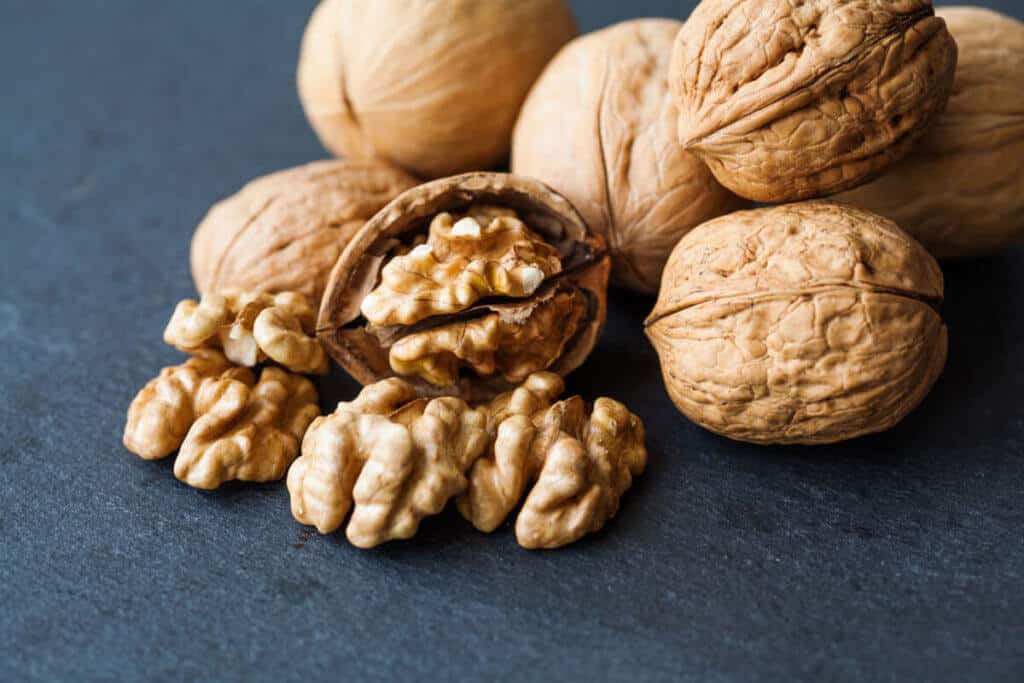Omega-3 fatty acids (n-3PUFAs) are considered essential because they cannot be made by the body, and must be obtained through dietary sources or supplements. (8) These essential omega-3 fatty acids have been proven to support the health of many key body functions including cardiovascular, immune, brain, and more. (7)
A 2018 cohort study featured in the British Medical Journal showed that higher cumulative levels of omega-3 fatty acids were correlated with a greater likelihood of healthy aging. (7) The researchers concluded, “These findings support guidelines for increased dietary consumption of n-3PUFAs in older adults.”

And it’s not just older adults who benefit from foods rich in omega-3 fatty acids. According to the National Institutes of Health Office of Dietary Supplements, the health benefits of omega-3 fatty acids are numerous. (8)
Health benefits of omega-3 fatty acids
Scientific literature suggests that the benefits of omega-3 fatty acids may include:
- Reduced risk of cardiovascular disease, certain cancers, and cognitive decline
- Reduced risk of certain ocular conditions (e.g., dry eye disease, macular degeneration)
- Increased infant birth weight when consumed during pregnancy
- Improved joint function (8)
What are fatty acids?
To understand omega-3 fatty acids, it’s important to note the difference between saturated and unsaturated fatty acids. Dietary fats typically contain a combination of both saturated and unsaturated fatty acids in various proportions. (12)
Saturated fatty acids are primarily found in animal sources and are solid at room temperature. The current Dietary Guidelines for Americans recommend limiting your consumption of saturated fats. (12) However, certain saturated fats demonstrate health benefits when consumed in moderate amounts, such as medium-chain triglycerides (MCTs) from coconut oil. (6)
Unsaturated fats, on the other hand, are mostly liquid at room temperature and are generally considered to be healthy fats. These fatty acids contain one or more double bonds in their carbon chain (chemical structure), which results in the fluidity of oils high in unsaturated fat. Unsaturated fats include monounsaturated fatty acids (MUFAs) and polyunsaturated fatty acids (PUFAs). (8)(12)
Omega-3 fatty acids
Commonly referred to as omega-3s, omega-3 fatty acids are PUFAs consisting of long carbon chains with two or more double bonds. (8) There are three key omega-3 fats, which include alpha-linolenic acid (ALA), docosahexaenoic acid (DHA), and eicosapentaenoic acid (EPA). ALA, derived from plant sources, is converted in the body to DHA and EPA. However, this conversion is limited, making it important to consume DHA and EPA, which are found in high levels in certain fish. (13)
Foods rich in omega-3 fatty acids
So which foods contain these essential omega-3 fatty acids? Below is a list of omega-3 fatty acid-rich foods, including seafood, seeds, nuts, and legumes.
Fish and seafood
Fish tops the list of foods high in essential fatty acids. The American Heart Association recommends that people eat at least two servings of fish each week. (1) A serving is equivalent to 3.5 ounces (about the size of a deck of cards) of cooked fish or a ¾ cup of flaked fish.
Fatty fish and fish oil are rich sources of omega-3 essential fatty acids. Fish that have the most omega-3s include mackerel, salmon, seabass, sardines, herring, tuna, and trout. While oysters and shrimp have less omega-3s than fish, they are still great sources of these essential fatty acids. Many studies have shown that eating seafood can help reduce the risk of certain illnesses, in particular, heart disease. (4)
Seeds
Plant-based foods such as seeds, nuts, and beans are great sources of the omega-3 fatty acid ALA. These include flax, chia, and hemp seeds. Flaxseeds have been shown to help reduce the risk of heart disease, osteoporosis, and certain cancers. (5) Seeds are essential fatty acid foods that also contain fiber and other important nutrients.

Walnuts
Many different types of nuts have health-promoting compounds. Walnuts, in particular, have been shown to support health on many levels because of their ALA content. (11) A 2018 randomized study of healthy men and women that was published in The Journal of Nutrition found that walnut consumption positively influenced the gut microbiome. (3) Because walnuts also contain potent polyphenols, minerals, melatonin, and vitamin E, they can help enhance immunity, and improve cardiovascular and mental health. (11) According to a 2016 randomized controlled trial published in the journal Nutrients, walnut consumption was associated with improved mood in young adults. (10)Beans
Beans—kidney, black, pinto, soy, etc.—also contain ALA. (2) Additionally, beans are a great source of plant-based protein and contain other beneficial nutrients, such as fiber and potassium. (12) Regular consumption of beans is associated with balanced cholesterol and blood pressure, as well as better glucose control and weight management. (9) Consuming beans may particularly help individuals on a vegan or vegetarian diet increase their dietary intake of omega-3s. (2)Food first, supplement second
Omega-3 fatty acids are also available in supplement form. Omega-3 supplements are commonly produced from algal oil, a vegetarian source, and various seafood sources, such as krill oil, fish oil, and cod liver oil. Consult with your practitioner for more information and guidance on dietary supplements.
The bottom line
Omega-3 fatty acids are essential nutrients for health which have been shown to promote healthy aging and reduce the risk of various diseases. You can increase your intake of omega-3s by consuming foods rich in omega-3 fatty acids, including fish, seafood, seeds, walnuts, and beans. If you’re interested in omega-3 supplements, we suggest working with your integrative practitioner before making any changes.- American Heart Association. (2017). Fish and omega-3 fatty acids. Retrieved from https://www.heart.org/en/healthy-living/healthy-eating/eat-smart/fats/fish-and-omega-3-fatty-acids
- Ghafoorunissa, & Pangrekar, J. (1993). Vegetables as sources of α-linolenic acid in Indian diets. Food Chemistry, 47(2), 121–124.
- Holscher, H. D., Guetterman, H. M., Swanson, K. S., An, R., Matthan, N. R., Lichtenstein, A. H., Novotny, J. A., & Baer, D. J. (2018). Walnut consumption alters the gastrointestinal microbiota, microbially derived secondary bile acids, and health markers in healthy adults: A randomized controlled trial. The Journal of Nutrition, 148(6), 861–867.
- Hosomi, R., Yoshida, M., & Fukunaga, K. (2012) Seafood consumption and components for health. Global Journal of Health Science, 4(3), 72-86.
- Kajla, P., Sharma, A., & Sood, D. R. (2015). Flaxseed—a potential functional food source. Journal of Food Science and Technology, 52(4):1857-1871.
- Khaw, K.-T., Sharp, S. J., Finikarides, L., Afzal, I., Lentjes, M., Luben, R., & Forouhi, N. G. (2018). Randomised trial of coconut oil, olive oil or butter on blood lipids and other cardiovascular risk factors in healthy men and women. BMJ Open, 8(3), e020167.
- Lai, H. T., de Oliveira Otto, M. C., Lemaitre, R. N., McKnight, B., Song, X., King, I. B., Chaves, P. H., Odden, M. C., Newman, A. B., Siscovick, D. S., & Mozaffarian, D. (2018). Serial circulating omega 3 polyunsaturated fatty acids and healthy ageing among older adults in the Cardiovascular Health Study: prospective cohort study. BMJ, 363, k4067.
- National Institutes of Health Office of Dietary Supplements. (2019). Omega-3 fatty acids. Retrieved from https://ods.od.nih.gov/factsheets/Omega3FattyAcids-HealthProfessional/
- Polak, R., Phillips, E. M., &Campbell, A. (2015). Legumes: health benefits and culinary approaches to increase intake. Clinical Diabetes, 33(4), 198-205.
- Pribis, P. (2016). Effects of walnut consumption on mood in young adults—A randomized controlled trial. Nutrients, 8(11), 668.
- Ros, E., Izquierdo-Pulido, M., & Sala-Vila, A. (2018). Beneficial effects of walnut consumption on human health: Role of micronutrients. Current Opinion in Clinical Nutrition and Metabolic Care, 21(6), 498-504.
- U.S. Department of Health and Human Services and U.S. Department of Agriculture. (2015). 2015–2020 Dietary Guidelines for Americans. 8th Edition. Retrieved from http://health.gov/dietaryguidelines/2015/guidelines/
- Welch, A. A., Shakya-Shrestha, S., Lentjes, M. A., Wareham, N. J., & Khaw, K.-T. (2010). Dietary intake and status of n–3 polyunsaturated fatty acids in a population of fish-eating and non-fish-eating meat-eaters, vegetarians, and vegans and the precursor-product ratio of α-linolenic acid to long-chain n–3 polyunsaturated fatty acids: Results from the EPIC-Norfolk cohort. The American Journal of Clinical Nutrition, 92(5), 1040–1051.





